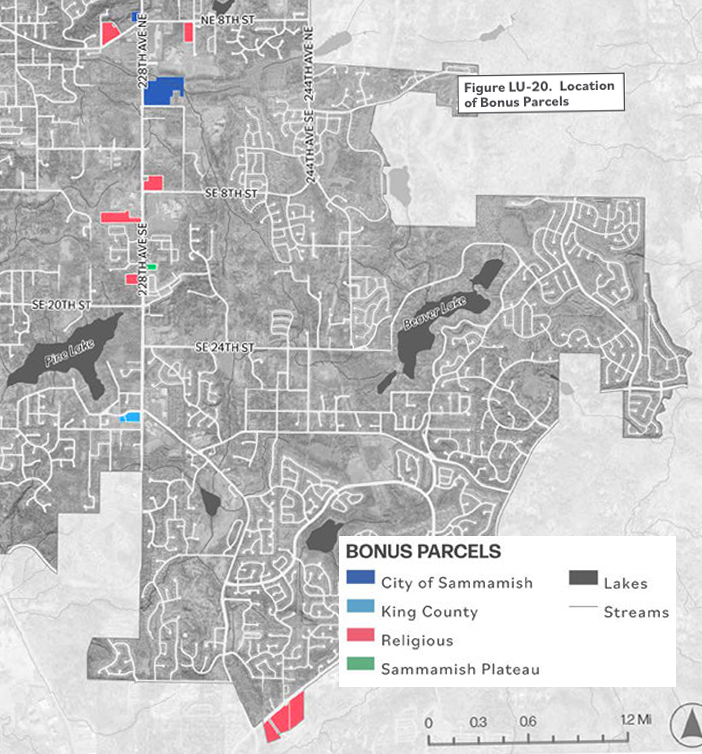Sammamish at a Crossroads
Right now, the Town Center is limited to 2,000 housing units. A group called Save Our Sammamish (SOS), along with city council candidates Josh Amato, Michael Boyer, and Debbie Treen, wants to keep it that way. Their message—“No to 4K”—is posted on blue yard signs across the city. But behind that slogan is a plan that could seriously undermine Sammamish’s future.
Here’s the reality:
Under the State’s Growth Management Act, Sammamish is required to plan for and accommodate 2,100 affordable housing units by 2044, most of which must serve households earning 50% or less of the area’s median income. According to state guidance, the only practical way to meet this mandate is through mid-rise apartments and condominiums, the kind of housing that fits best in a walkable, transit-oriented Town Center.
But there’s a problem.
Without raising the Town Center’s housing capacity, the City cannot offer the developer incentives needed to build these types of affordable units. With the current 2,000 housing unit limit, the developer will default to what’s most profitable: townhomes, minimal commercial space, and only 200 affordable units (10% required by the city). That still leaves 1,900 affordable units that need to be accommodated.
So where would those remaining 1,900 affordable units go?
Sammamish’s other mixed-use areas, Klahanie, Inglewood, and Pine Lake, are alternatives, but they're controlled by a single real estate management company that has shown little interest in redevelopment. In the 30 years I’ve lived here, the most that’s changed is a fresh coat of exterior paint.
Instead, the City will need to plan for these affordable apartments and condos on scattered city-owned, county, religious, and water district parcels, mostly located along 228th Street. These "Bonus Parcels" were never intended to bear the full weight of our housing obligations. This shift would put significant pressure on 228th, without delivering the benefits of concentrated development: improved transit and a walkable and vibrant city center.
Let’s be clear: “No to 4K” in the Town Center just means 1,900 affordable apartments and condos will be pushed onto Bonus Parcels scattered along 228th, leading to more traffic congestion, fragmented growth, and misplaced development.
Now, consider the alternative:
If we responsibly increase the Town Center’s capacity up to 4,000 units (that number is still to be determined during the Town Center Plan update later this year), the City can negotiate stronger incentives with the developer. Instead of just 10% (200 units) being affordable, we could see up to 30%, potentially 1,200 affordable units, built right in the heart of a walkable, transit-ready neighborhood. This wouldn’t happen overnight, full build-out at that level is estimated to take more than 50 years.
With smart, concentrated growth in Town Center, we gain:
Improved transit, including potential Metro RapidRide service
Preservation of green spaces in other parts of the city
More efficient land use through increased housing density
A vibrant, walkable hub with shops, restaurants, services, and public gathering spaces
Additional city sales tax revenue from the businesses to fund city services
Lower infrastructure and long-term maintenance cost
A stronger sense of community
So what’s really at stake?
The vision promoted by SOS, Amato, Boyer, and Treen is not just shortsighted, it’s out of sync with the reality of Sammamish’s future. Their plan would:
Push affordable housing onto scattered parcels along 228th and beyond
Undermine our ability to meet our state affordable housing mandate
Eliminate the opportunity for major transit improvements
Limit commercial and retail development in Town Center
Continue the over reliance on property tax to fund city services
Permanently prevent Sammamish from building a true community space
Once the Town Center is filled with townhomes, the window to create a vibrant, mixed-use, transit-friendly community will close—for good. We have a choice. Let’s make the one that supports a sustainable, inclusive, and connected Sammamish.
Bonus Parcels, Page 139, Sammamish Comprehensive Plan


